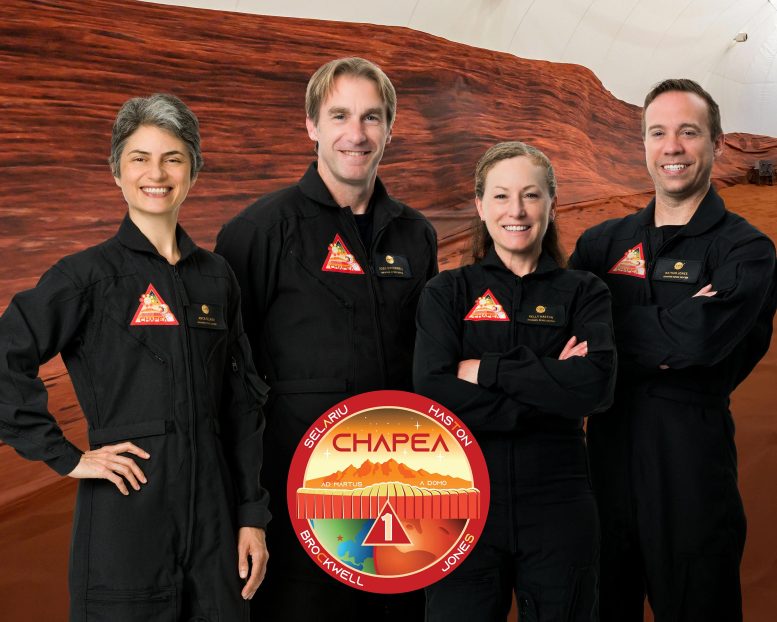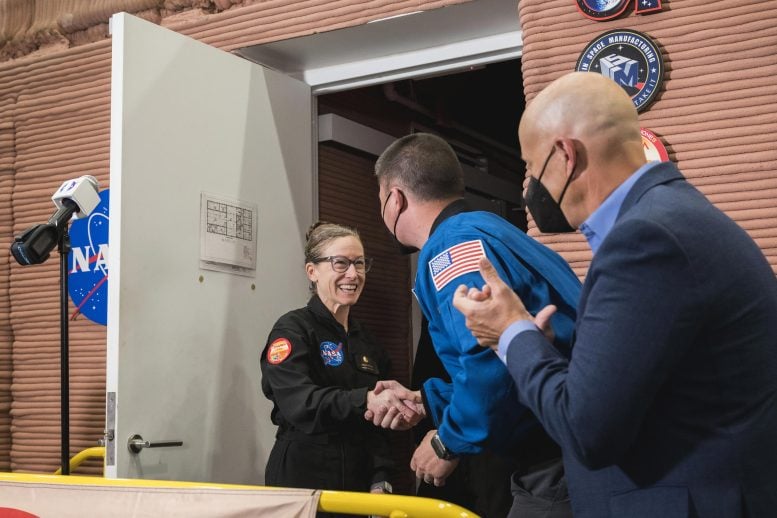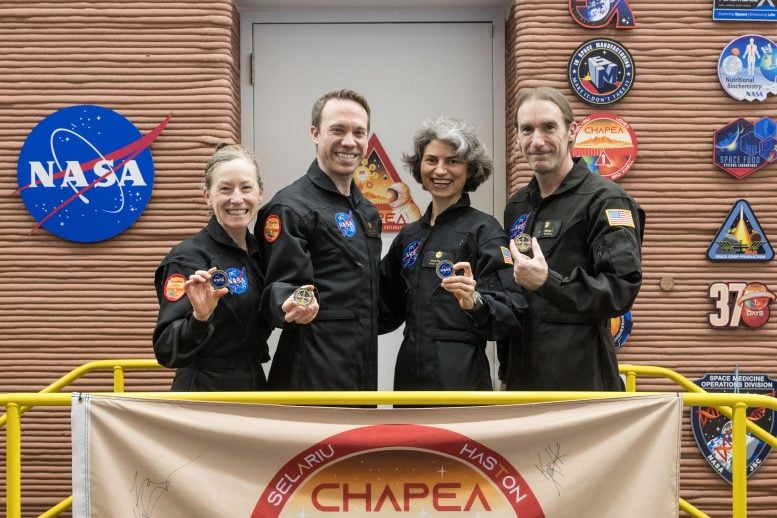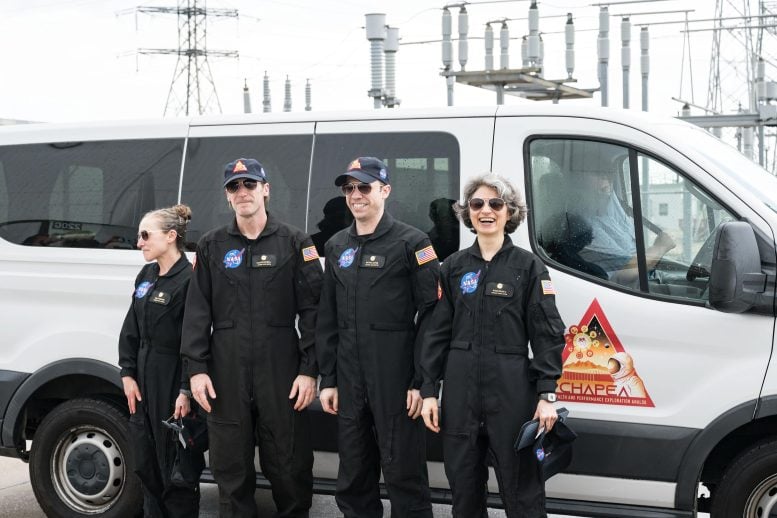
NASA’s inaugural CHAPEA crew completed a year-long simulated Mars mission at Johnson Space Center, involving four crew members who lived in a 3D-printed habitat to assess human health and performance in isolation and confinement.
The simulation, part of NASA’s broader Artemis campaign, aims to prepare for future manned missions to Mars with additional analog missions planned through 2025 to expand research data.
The inaugural CHAPEA (Crew Health and Performance Exploration Analog) crew is “back on Earth” after walking out of their simulated Martian habitat at NASA’s Johnson Space Center in Houston on July 6. The first of three simulated missions, CHAPEA Mission 1 was designed to help scientists, engineers, and mission planners better understand how living on another world could affect human health and performance.

The CHAPEA Mission 1 Crew
Kelly Haston, commander, Ross Brockwell, flight engineer, Nathan Jones, medical officer, and Anca Selariu, science officer, lived and worked in an isolated 1,700-square-foot, 3D-printed habitat to support human health and performance research to prepare for future missions to Mars.
“Congratulations to the crew of CHAPEA Mission 1 on their completion of a year in a Mars-simulated environment,” said NASA Administrator Bill Nelson. “Through the Artemis missions, we will use what we learn on and around the Moon to take the next giant leap: sending the first astronauts to Mars. The CHAPEA missions are critical to developing the knowledge and tools needed for humans to one day live and work on the Red Planet.”
The crew stepped out of the habitat and back into the arms of family and friends after a 378-day simulated Mars surface mission that began June 25, 2023.

The Rigors of Simulated Mars Missions
This high-fidelity simulation involved the crew carrying out different types of mission objectives, including simulated “marswalks,” robotic operations, habitat maintenance, exercise, and crop growth. The crew also faced intentional environmental stressors in their habitat such as resource limitations, isolation, and confinement. For the next two weeks, the volunteers will complete post-mission data collection activities before returning home.
“We planned the last 378 days with many of the challenges crews could face on Mars and this crew dedicated their lives over that time to achieve these unprecedented operational objectives,” said CHAPEA Principal Investigator Grace Douglas. “I am looking forward to diving into the data we have gathered, preparing for CHAPEA Mission 2 and eventually, a human presence on Mars.”

CHAPEA’s Broader Impact on Space Exploration
As NASA works to establish a long-term presence for scientific discovery and exploration on the Moon through the Artemis campaign, analog missions like CHAPEA provide scientific data to validate systems and develop technological solutions for future missions to Mars.
Two additional one-year CHAPEA missions are planned, with the next targeted to begin in 2025. The subsequent missions will be nearly identical, allowing researchers to collect data from more participants to expand the dataset and provide a broader perspective on the impacts of Mars-realistic resource limitations, isolation, and confinement on human health and performance.
Expanding the Scope of Isolation Research
NASA has several other avenues for gathering isolation research, including the Human Exploration Research Analog, Antarctica, and other analogs, as well as human spaceflight missions to the International Space Station to ensure key research goals can be completed to inform future human missions to the Moon and Mars.
The CHAPEA simulated missions are unique because they test the impacts of extended isolation and confinement with the addition of Mars-realistic time delays of communicating to Earth – up to 44-minutes roundtrip – along with resource limitations relevant to Mars, including a more limited food system that can be supported on the space station and in other analogs.
View the ceremony of crew exiting their habitat:
The four volunteers who have been living and working inside NASA’s first simulated yearlong Mars habitat mission egress their ground-based home on Saturday, July 6. The first Crew Health and Performance Exploration Analog (CHAPEA) mission began in the 3D printed habitat on June 25, 2023, with crew members Kelly Haston, Anca Selariu, Ross Brockwell, and Nathan Jones. For more than a year, the crew simulated Mars mission operations, including “Marswalks,” grew and harvested several vegetables to supplement their shelf-stable food, maintained their equipment and habitat, and operated under additional stressors a Mars crew will experience, including communication delays with Earth, resource limitations, and isolation. Credit: NASA Johnson
Under NASA’s Artemis campaign, the agency will establish the foundation for long-term scientific exploration at the Moon, land the first woman, first person of color, and its first international partner astronaut on the lunar surface, and prepare for human expeditions to Mars for the benefit of all.
3 Comments
But they cannot simulate the differently charged environment. We know this is not a non zero, because the dust on rovers spontaneously is ejected and they ‘self clean’. We know ejected because the remaining dust bits shows no wind chevrons and conical formations.
So, an extra long submarine patrol.
Not sure how they were able to simulate the effects of reduced gravity, nor how they were able to simulate the real issues of supplying enough water and breathable atmosphere for a mission that would last as long as 900 days, and there is no escaping the understanding that all they had to do to be safe was to step outside the habitat. The actual crew will not have that advantage.
If crew selection is based on anything other than those volunteers best equipped and qualified for that kind of mission length, it will fail. Fist woman? POC? Foreign national? if those selection criteria are real, then this program is toast.
I wanna know what they did with their waste. Use it as fertilizer, re-cycle, leave it in a porta-potty, or pack it out…